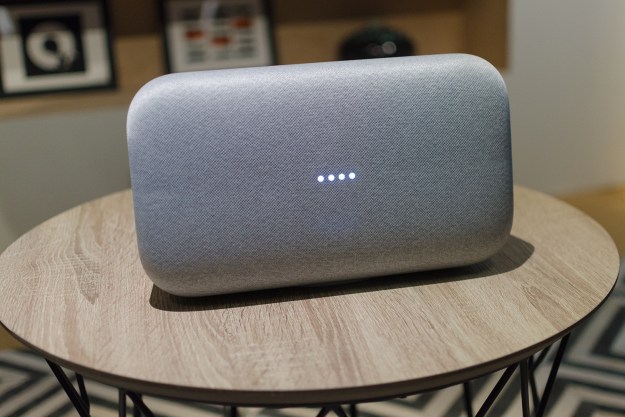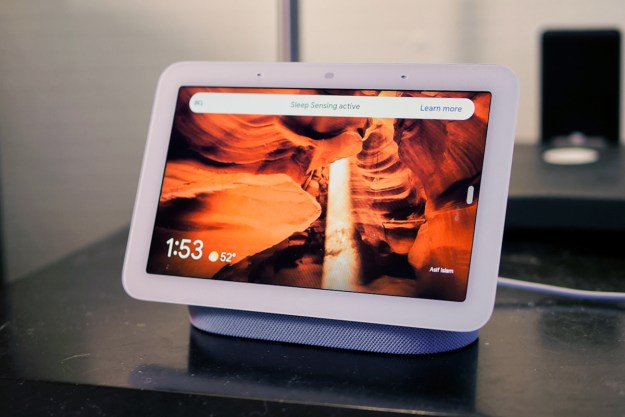
- Powerful sound with gobs of bass
- Can pair with multiple devices
- Assistant is as useful as ever
- Supports many music streaming services
- Expensive
- Can't work as a wireless TV sound bar
Google’s answer to Amazon’s Alexa-enabled Echo was the Google Home, a $120 speaker that’s powered by the artificially intelligent Google Assistant. The Home family expanded recently when Google announced third-party manufacturers are building Assistant-enabled speakers, but Google itself now has two alternatives to its main offering — the Google Home Mini, and the Google Home Max. The latter is a much larger speaker than any of its peers, and there’s good reason for that.
Not a dumb old speaker
As the name suggests the Google Home Max sits at the top tier of the Google Home product line. It’s a massive speaker meant to rival Apple’s upcoming HomePod, but with Google Assistant integration.
It weighs 11.7 pounds, and it’s wrapped in “acoustically transparent” fabric like that on the Mini. It comes in black or white and looks elegant and sleek, but we don’t think it will blend seamlessly into your home. It’s eye-catching thanks to its size. Unlike it’s little sisters, the Google Home and Home Mini, this device is heavy and bulky. You’ll want to make sure that it’s in a secure place in your home, as it might not survive an accidental fall.
- 2. Google Home Max
Set up of the Max is pretty straightforward — all you need to do is plug in the device, download the Google Home app if you haven’t already, and follow the setup instructions from there. Like the Mini, you can perform all the same Assistant functions such as controlling your smart home. There are currently dozens of smart home devices compatible with the Google Assistant, with more being added each day.
Just like the Mini, you can set up Voice Match so that the Max recognizes your voice and gives you tailored answers to your directives. For example, when you say, “Hey Google, what does traffic look like on my way to work?” it’ll recognize your voice and give you your commute details rather than your partner’s. With firmware updates to the app, Google continues to add other bells and whistles to its smart speaker. For example, you can make calls, add items to your grocery list, or find out which city hosted the 2004 Summer Olympics (answer: Greece) — all with a voice command.
Big, bold, and all about that bass
Let’s be clear: The Max isn’t really designed to be a smart speaker with great sound. It’s a great speaker that happens to have a smart assistant built in.
The Max supports HE-AAC, LC-AAC+, MP3, Vorbis, WAV, FLAC, and Opus audio formats, and you’ll find 2.4GHz and 5GHz Wi-Fi for high-performance streaming, and Bluetooth 4.2. There’s an auxiliary port on the rear if you want to connect the Max to a record player (believe us, you do), and a USB-C port lets you connect an Ethernet cable via a USB-C to Ethernet dongle. There are two 4.5-inch woofers and two 0.7-inch tweeters. Google said the Max optimizes sound based on the room it’s placed in (the company calls this “Smart Sound”), and the Max can hear you across the room even when it’s playing.
We tried the latter when the Max was blasting music, and it took two tries. It didn’t hear us the first time, but when we practically shouted “Hey Google” when we were standing near, it picked up the voice trigger, and let us command it. We were skeptical how well the Max would pick up voice commands when you’re playing music at louder volumes, but the speaker did respond.
Controls of the speaker can be verbal or touch-based. Tap the center to play and pause, and press and hold to activate the Assistant (or say “Hey Google). You can slide your finger on the side or top of the device to control sound — depending on whether it’s sitting upright or laying flat horizontally.
How does it sound? Impressively loud, and sound signature is huge on bass. Like, insane amounts of bass. It’s even more impressive when you pair one Max with another for stereo audio. You can also pair it with all other Chromecast Audio or Google Home products, in case you want to play your music around the house.
Even if the sound quality is great, you’ll still want to use your preferred music service. Google thankfully has a wide-array of support including Spotify, Google Play Music, YouTube Music, Pandora, TuneIn, and iHeart Radio. Apple Music and Tidal streamers, you’re out of luck.
The sound signature is huge on bass. Like, insane amounts of bass.
There’s currently no way to have the Google Home Max act as a wireless sound bar for your TV. Google told Digital Trends it’s a highly requested feature that the company is looking into, but it will take time to overcome some technical challenges such as syncing the audio and video. You could, however, connect a TV’s analog audio outputs to the Max’s 3.5 mm analog audio input with an adapter cable, though.
The downside of the Max could be its price tag. At $400, it’s more expensive than the upcoming Apple HomePod, which aims to offer high-quality audio playback and quick access to Siri. Even the recently announced Sony LF-S50G is just $200, and that product builds on the company’s heritage and history in the music space. Those are fair smart speaker comparisons, but from a sound quality perspective, the Riva Festival and Sonos Play:5 are much closer in features, sound performance and price.
The Riva Festival is a more balanced-sounding speaker. It belts out the bass without bowling you over, and gets nice a deep in the low end while holding down translucent midrange and detailed, accurate treble. The Sonos Play:5 is a little more spritely and in-your-face with its sound than the Riva, and has slightly more pronounced low end, but it still offers an air of refinement that the Max lacks.
If the Riva Festival is a class-act Jazz musician and the Sonos Play:5 is a wealthy, Mercedes-driving business man, the Google Max is your best buddy who really likes to party. The Max offers high-quality sound, is extremely powerful, and the bass is — well, again, it’s huge and deep. Google’s not wrong to use legendary DJ Diplo in its ad campaign. This is exactly the kind of speaker a DJ would dig, and we feel the generation that digs the big bass Beats headphones affords will be absolutely ecstatic with the way this speaker sounds.
The Google Home Max is now available to buy at Best Buy, Walmart, Verizon, and the Google store.
Warranty information
Google offers a basic one-year warranty covering any defects in materials or workmanship under normal use. You’ll find further details at Google’s warranty page for the Max.
Our Take
The Google Max is a speaker first, with Google Assistant tossed in for added smarts and connectivity. If you crave a powerful speaker with massive amounts of bass and rock-solid overall sound, the Google Max is what you’re looking for. We may have been balking at that $400 price tag from afar, but every sent of that sum is paid back with what the speaker can do to rock a party.
Is there a better alternative?
For more refined tastes, the Sonos Play:5 and Riva Festival are both great sounding speakers. It should be noted that while the Riva Festival can work in a multi-room configuration, it’s got no smarts — no Alexa; no Google Assistant; no Siri. The Sonos Play:5 can now work with Alexa through your mobile device, but it doesn’t support voice commands, so it falls short of the Google Home Max’s superior smart speaker abilities.
How long will it last?
With three smart speakers in the family, Google and Google Assistant are obviously here to stay. The list of apps and devices that work with the assistant will only continue to grow, and Google often issues software updates to add features and bring more capabilities.
Should you buy it?
Yes. The Google Home Max is the smart speaker of choice for those who want huge sound for a seriously fun time.
Editors' Recommendations
- The most common Google Home problems and how to fix them
- Roborock S8 MaxV Ultra vs. Narwal Freo X Ultra: Which is the best premium robot vacuum?
- Best security camera deals: Ring, Arlo, Blink and more on sale
- How to use the Google Home app on a computer
- The best smart light switch for Alexa, Google Home, and HomeKit










